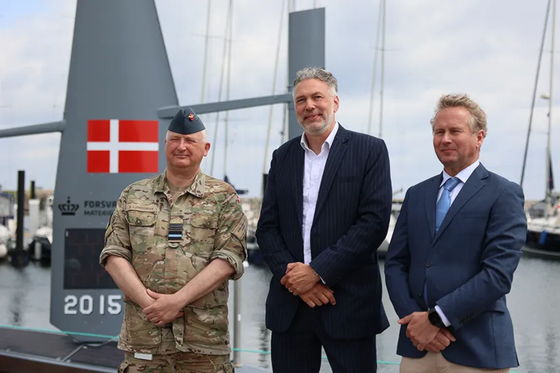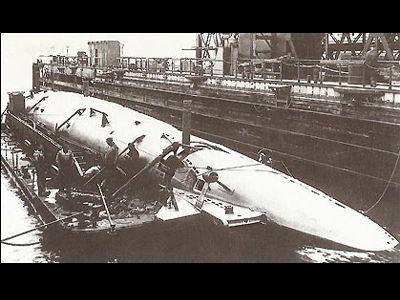Denmark begins testing military maritime drones that can operate autonomously at sea for months, powered by wind and solar power

The Danish military has announced that it has begun testing an unmanned surface vehicle that can be powered by wind and solar power and operate autonomously for several months.
The Future of Maritime Surveillance Launches in the Baltic Sea – Saildrone

Saildrone sat i søen – Forsvaret tester ny kurs for maritim overvågning
https://www.fmi.dk/da/nyheder/2025/saildrone-sat-i-soen--forsvaret-tester-ny-kurs-for-maritim-overvagning/
Denmark launches robotic sailboats for surveillance in Baltic and North Seas | AP News
https://apnews.com/article/denmark-robot-sailboats-baltic-sea-bfa31c98cf7c93320115c0ad0e6908c5
On June 16, 2025 local time, in cooperation with the Danish Ministry of Defence Procurement and Logistics Organisation (DALO), four Saildrone -built Voyager unmanned surface vehicles (USVs) will be deployed on a three-month test mission. The Voyagers will patrol the Baltic Sea , the North Sea , Danish territorial waters and NATO territorial waters, areas where maritime tensions and suspicions of sabotage have risen sharply since Russia's invasion of Ukraine in 2022 .
Today marks a major milestone in the evolution of maritime autonomy in Europe: Four Saildrone Voyager USVs have been deployed for a three-month mission in the Baltic Sea! 🇩🇰🇪🇺 https://t.co/e3q33AcITu pic.twitter.com/FiVZWKUvqL
— Saildrone (@saildrone) June 16, 2025
The mission marks the Danish military's first test of Voyager and reflects the close cooperation and collaboration between Saildrone and DALO. In spring 2025, Saildrone announced it would receive a strategic investment from the Danish Export Investment Fund (EIFO) to establish a new subsidiary based in Denmark.
Below is a video of Voyager, which the Danish military has begun test operations of, sailing in the Baltic Sea. Note that the video below was taken on June 6, 2025, before the start of the test operation, and the two Voyagers shown in the video are participating in NATO patrols.
Saildrone's unmanned surface boat 'Voyage' launched by the Danish military for testing - YouTube
The Baltic Sea is a critical area of increasing geopolitical complexity. It is home to a high concentration of critical undersea infrastructure such as pipelines and data cables, and it borders several NATO member and partner nations. Located at the maritime crossroads of the North and Baltic Seas with increasing naval activity, Denmark is in a uniquely complex position to take the lead in improving maritime security and situational awareness.
The Danish Armed Forces' deployment of Voyager demonstrates clear leadership in addressing regional challenges. The introduction of an autonomous intelligence, surveillance and reconnaissance (ISR) system will enhance Denmark's USVs' ability to ensure freedom of navigation, protect critical maritime infrastructure, and contribute to allied readiness.
'The Baltic Sea, North Sea and the European Arctic are currently facing unprecedented threats,' said Richard Jenkins, founder and CEO of Saildrone. 'We are excited to partner with the Danish Armed Forces and deploy Saildrone systems to help protect Europe's critical undersea infrastructure and improve regional security.'
Pictured below, from left, are Lieutenant General Kim Jesper Jørgensen, DALO's National Armaments Directorate, Jacob Arup Brattingh Pedersen, Managing Director and Partner at EIFO, and Saildrone CEO Jenkins.

You can watch the video below to see the press conference announcing Voyager's test operations, which was attended by Vice Admiral Jorgensen, Pedersen, and CEO Jenkins.
Press conference announcing the Saildrone unmanned surface boat 'Voyage' to be test-operated by the Danish military - YouTube
Voyager can run on wind and solar energy, as well as diesel power and electric propulsion, enabling it to provide continuous surveillance over wide areas while significantly reducing its carbon footprint compared to conventional manned maritime surveillance aircraft.
Voyager is equipped with cutting-edge marine sensors, including radar, Automatic Identification System (AIS) and camera systems with computer vision. With secure satellite communications and full autonomy, it can operate at sea for months on end, continuously collecting and transmitting actionable intelligence.
According to CEO Jenkins, Voyager will use machine learning and artificial intelligence (AI) to capture a 'full view above and below the surface' of the open ocean at depths of about 20 to 30 miles (about 30 to 50 km). Voyager will be able to monitor ocean threats such as damage to undersea cables, illegal fishing, and smuggling of people, weapons and drugs. Saildrone explains that Voyager will 'go where eyes and ears have never been able to reach before.'
Peder Lundquist, CEO of EIFO, said: 'We are very pleased to be investing in Saildrone and that Denmark has been chosen as the hub for their European activities. Saildrone is a leading company in a fast-growing market and access to this technology could be crucial to Danish and European security. At a fraction of the cost of patrol vessels, we expect Saildrone to have an impact on both the Danish defence industry and Danish agendas such as monitoring the Arctic and countering sabotage in Danish waters.'
'It's simply too expensive to track every single Russian vessel, whether they're a warship or a civilian cargo ship,' said Peter Viggo Jacobsen of the Royal Danish Defence College. 'We're trying to build a layered system that can constantly monitor for potential threats at a much cheaper level than was previously possible.'
Related Posts:







